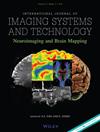利用U-Net深层结构改进语义分割的胸部CT图像中新冠肺炎的有效量化
IF 3
4区 计算机科学
Q2 ENGINEERING, ELECTRICAL & ELECTRONIC
引用次数: 0
摘要
事实证明,冠状病毒(新冠肺炎)疫情在全球范围内的传播对公共卫生造成了破坏。肺炎的严重程度取决于CT图像对新冠肺炎的快速准确诊断。因此,计算机断层扫描(CT)是检测新冠肺炎的优秀筛查工具。本文提出了一种基于深度学习的策略,用于从胸部CT图像中识别和分割新冠肺炎病变,这将为医生提供关于患者严重程度的准确计算机辅助决策标准。提出了检测新冠肺炎的两个主要阶段;首先,卷积神经网络(CNN)深度结构从CT图像中识别和分类新冠肺炎。第二,U-Net深层结构以语义方式分割新冠肺炎区域。在新冠肺炎的三个不同CT数据集上对所提出的系统进行了训练和评估,其中两个用于说明系统的分割性能,另一个用于证明系统的分类能力。实验结果表明,所提出的CNN可以实现大于0.99的分类精度,并且所提出的U-Net模型在分割方面优于现有技术,IOU大于0.92。本文章由计算机程序翻译,如有差异,请以英文原文为准。
An efficient quantification of COVID-19 in chest CT images with improved semantic segmentation using U-Net deep structure
The worldwide spread of the coronavirus (COVID‐19) outbreak has proven devastating to public health. The severity of pneumonia relies on a rapid and accurate diagnosis of COVID‐19 in CT images. Accordingly, a computed tomography (CT) scan is an excellent screening tool for detecting COVID‐19. This paper proposes a deep learning‐based strategy for recognizing and segmenting a COVID‐19 lesion from chest CT images, which would introduce an accurate computer aided decision criteria for the physicians about the severity rate of the patients. Two main stages have been proposed for detecting COVID‐19; first, a convolutional neural network (CNN) deep structure recognizes and classifies COVID‐19 from CT images. Second, a U‐Net deep structure segments the COVID‐19 regions in a semantic manner. The proposed system is trained and evaluated on three different CT datasets for COVID‐19, two of which are used to illustrate the system's segmentation performance and the other is to demonstrate the system's classification ability. Experiment results reveal that the proposed CNN can achieve classification accuracy greater than 0.99, and the proposed U‐Net model outperforms the state‐of‐the‐art in segmentation with an IOU greater than 0.92.
求助全文
通过发布文献求助,成功后即可免费获取论文全文。
去求助
来源期刊

International Journal of Imaging Systems and Technology
工程技术-成像科学与照相技术
CiteScore
6.90
自引率
6.10%
发文量
138
审稿时长
3 months
期刊介绍:
The International Journal of Imaging Systems and Technology (IMA) is a forum for the exchange of ideas and results relevant to imaging systems, including imaging physics and informatics. The journal covers all imaging modalities in humans and animals.
IMA accepts technically sound and scientifically rigorous research in the interdisciplinary field of imaging, including relevant algorithmic research and hardware and software development, and their applications relevant to medical research. The journal provides a platform to publish original research in structural and functional imaging.
The journal is also open to imaging studies of the human body and on animals that describe novel diagnostic imaging and analyses methods. Technical, theoretical, and clinical research in both normal and clinical populations is encouraged. Submissions describing methods, software, databases, replication studies as well as negative results are also considered.
The scope of the journal includes, but is not limited to, the following in the context of biomedical research:
Imaging and neuro-imaging modalities: structural MRI, functional MRI, PET, SPECT, CT, ultrasound, EEG, MEG, NIRS etc.;
Neuromodulation and brain stimulation techniques such as TMS and tDCS;
Software and hardware for imaging, especially related to human and animal health;
Image segmentation in normal and clinical populations;
Pattern analysis and classification using machine learning techniques;
Computational modeling and analysis;
Brain connectivity and connectomics;
Systems-level characterization of brain function;
Neural networks and neurorobotics;
Computer vision, based on human/animal physiology;
Brain-computer interface (BCI) technology;
Big data, databasing and data mining.
 求助内容:
求助内容: 应助结果提醒方式:
应助结果提醒方式:


